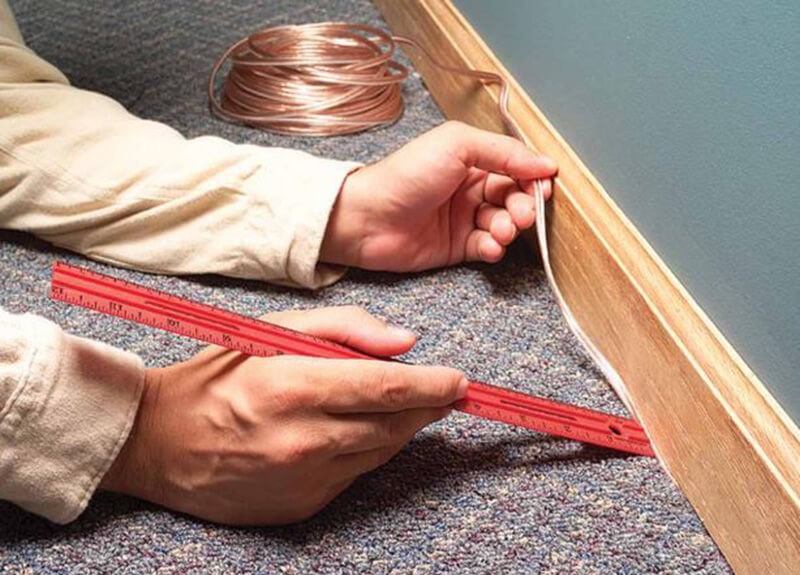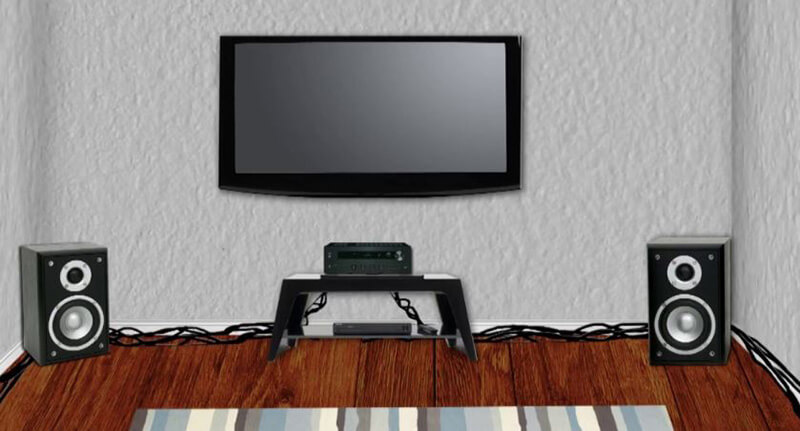Are you looking for How to hide speaker wire? LessConf will help you to find out the best way here!
Houses have styles and interior finishes. Irrespective of the design your living space might have, you may find it hard to arrange the distance whenever you’ve got a music system.
Once you have speaker cables throughout your 15, this can be made even harder. How you place your audio system things a lot and you will need to maintain your house speaker wires arranged so your home looks fantastic constantly.
Hiding them might not be simple for everybody. Fortunately, it requires some solutions that are simple to keep them wires observable. Keeping them concealed will reduce risks of tripping in addition to maintaining your space. Here are just several ways about the best way best to conceal home speaker cables.

The Greatest Ways How To Hide Speaker Wire
[amazon bestseller=”Speaker” items=”10″ template=”list”]
Foam Crown Molding
Crown molding is an addition to rooms, but it is not the simplest project to perform yourself. You might choose to go foam if you would like to handle it to theatre space or your loved ones. 12 fashions are offered by the NM collection from Foam Crown Molding of no molding’ and guests will probably be none the wiser for their material.
Molding bits arrive in 6-foot-6 lengths, and they may be trimmed with a razor knife, miter saw or hand saw. They paste adhering with painters. Independent installation kits, including spackle, caulking instrument, sanding pad, and caulk, operate $20.50 to $60.45 to get 40-foot into 400-foot room dimensions, respectively (and in between).
Dimensions move from 1 1/8 to 1 1/8 in to 5.25 x 5.625 inches, leaving dead space between the wall and molding to conceal wires. End’em with a coating of paint and you are all set.
Covering Them With Rugs
In the event the speaker wires need to run upon the ground, particularly once you’ve got a surround sound setup, then it is simple to conceal them with throw rugs. Additionally, it is possible to utilize carpet runners. Hiding them decreases odds of tripping over the cables and will add appeal.
But rugs may not cover all inches of house speaker cable that is vulnerable. The fantastic thing is there a solution which could keep your space appearing neater. This remedy isn’t permanent such you may always eliminate the carpets whenever you want and replace them. You can relocate rugs and the wires without the necessity for tools or any installments.
You may even conceal home speaker cables with carpeting over your carpeting or even straight on the ground. Whichever way, it is a good idea to use throw rugs having exactly the identical mat dimensions.
The pads help in preventing carpets from slipping and make it much easier to vacuum the distance. The pods operate like a different layer of protecting the wires. The mat makes it effortless for the carpeting.
In the event you’ll use this technique in a region where your family moves across too frequently, then you need to put in a slender wire cover to encase the cables under the carpets to get additional cushioning.
Utilizing throw rugs to conceal speaker wires will provide you the freedom to select between any color and pattern you would like. You cosmetic and can get creative with rugs.
Managing Wires
Prior to starting, be certain everything is disconnected and set where you need it. Plan to have additional spools of speaker cord available–proceed with 16 estimates for links up to 20 feet, 14 estimates for anything more than that–as some methods will need the excess length.
Useful tools to have available are cable strippers, tape measure or ruler, pliers, utility knife, scissors, twist/zip ties, bubble level, basic gun, cordless drill, hammer, hammer, and a stud finder. (And if you just happen to be leasing the space you reside in, double-check permissions along with your landlord prior to making any permanent alterations to the house.)
Camouflaging Speaker Wires with Paint
Your music system integrates wall-mount speakers, then the walls will operate across. If that is true, then it is simple to conceal them by painting them with exactly the identical color as the wall. This procedure requires a tiny bit more work because you have to run the cables directly and company along the walls.
You can achieve this with zip ties and a staple gun. You may just staple the ties across the wall. Position the cable over the principles and secure the zip tie. In this manner, you won’t staple the cables to prevent damaging them.
You are able to do this once every couple inches and then trim any extra zip ties. As soon as you’ve put the wires directly and securely in place, receive a matching paint and then paint across the speaker cables and zip ties to camouflage them. This technique is semi-permanent because you are able to eliminate the wires without a lot of harm on the walls.
Wiremold CornerMate Cord Organizer
When you’ve painted partitions, such as shown in the photograph, you may find Wiremold’s CornerMate Cord Organizer running up for your on-wall or shelf-mounted speakers.
Ah, the manufacturers thought of this, however, so they comprised paintable station covers (the simple kit includes four) — or in case you’ve got a white space, then you are pretty much set.
You receive four 30-inch corner cable stations and four paintable station cover, and four transition bits for linking other Wiremold products, such as the CableMate along with also the CordMate II for longer distances around the area.
The inside measurements of the channel have been 1-1/4 x 1/2 inches so there is lots of space to include exactly what you want.
Performed Between Baseboards and Carpets
If your house is carpeted, it is very possible that you also possess baseboards lining almost every area. Baseboards are generally installed slightly off the ground so as to permit space for the carpet.
There should also be a difference between the tack strip and the wall, under the carpet and baseboard. This region makes for a fantastic way to subtly run speaker cable around and between chambers.
Have a section of cord and see if you’re in a position to tuck it between the carpet and baseboard with your fingers. In the event, the space appears tight, then consider using a slender ruler or screwdriver to gently shove the cable to the wall until it shows.
If all goes well, measure and put out enough cabling so that speakers may reach stereo gear. Tuck wires beneath the baseboards before linking the ends. Although this method ought to be simple for many, a few individuals could realize the spaces between rugs and baseboards are simply too tight to squeeze wires in with palms.
If that is true, begin at one side and use a set of pliers to carefully pull a section of carpeting. You ought to be able to find the exposed hardwood floor, the tack strip (it is sharp, so watch your fingers), and the crevice between the wall and sew strip (beneath the baseboard).
Slide the speaker cord in, then push the carpet border down to the tack strip. Continue working your way around until each of the speaker cables was hidden.
Installing Cable Ducts or Covers
If you would like to conceal home speaker cables utilizing a more durable method, then you can just utilize cable ducts (also referred to as cable raceways). They are perfect where you want to hide speaker cable covering longer distances within your property. This remedy can also be great in a place that doesn’t own carpeting.
These cable ducts frequently arrive as kits with all parts such as adhesive tape, covers, anchors, joints, and other linking elements. It is possible to pick between a duct that is going to keep the speaker wires tucked open or perhaps enclosed inside the duct. Most cable vents are developed to be unobtrusive and streamlined such that you could even paint them with a fitting color when installed over the walls or baseboards.
Though utilizing cable canals is an excellent method to conceal home speaker cables, it is not simple to eliminate the raceways and speaker cables following setup. A much better choice is utilizing cable covers. They are constructed using PVC or rubber.
Covers leave any hint to remove them. They are perfect where speaker cables run across an open area. They are available in colors and various patterns you are able to use them to make the room more decorative.
Advance Wire Solutions Adhesive Backed Tape Wire
This will not be pain-free and smooth-looking since the picture makes it out to be, but AWS’ one-two-three measure adhesive-backed tape cable might be your response –particularly if you’re deft using all the painting and spackler abilities. The adhesive backing could not be much easier for sticking cable to walls (or even baseboards( possibly ).
In conclusion, the organization states by bending the copper conductors round the cable can be connected to kinds of speakers. You use the breaker around to fold, put it, and can use a paper clip for a mold.
Additionally, standard speaker hooks may be crimped onto; to utilize screw-on style straps, slit the horizontal conductors using scissors, then thread the sliced cable into one side of this screw-on connector, then fold the ends over, and twist on the opposite side of this pin as directed onto the connector instructions.
The cable comes in 12/2 into 18/4 AWG to get surround-sound applications and can be just .012-inch thick to lay flat. You might need to test out Gekko and FlatWire products in case you are looking into the cable.
With Flat Adhesive Home Speaker Wire
You want an invisible and permanent remedy to conceal home speaker cable consider using adhesive wires that are flat. With this cable is peel off a pay onto the cable to expose the adhesive. The glue holds on all surfaces.
This speaker cable is such and slender that it can be run by you. It’s possible to paint the side outdoors with a color facing. You won’t need to cut any holes through the ceiling or the walls. Don’t forget to follow the product directions while linking and installing an adhesive house speaker cable.
Though a few of the methods are DIY jobs seek the support of a professional house speaker cable installer you aren’t certain about a solution. In addition, remember to seek approval in the event you’ll make alterations to a living area that is leased.
Hide Along With Light Strips
It is possible to help conceal the truth that speaker wires are located by decorating using LED light strips if the painting is not more your thing than fairly lights.
LED lighting strips can be found with a number of lengths, lumens (brightness), temperatures (warm/cool), output colors, fabrics, and features. Though a power supply can be used by some, Many are powered by AC wall adapters.
Though others may be controlled via a program many include remotes. With such lights speaker cables can run alongside under, and few are any the wiser.
Bear in mind that light strips are only that–LEDs using a peel-away backing which allows them to adhere to surfaces.
Some, such as the Ability Practical Luminoodle, are much more like LED ropes that come with accessories. But if you would like to be in a position to readily adjust/relocate light strips in the long run, consider using Decorating Clips or even Command Wire Hooks.
These products adhere to a lot of surfaces and (typically ) could be safely removed without leaving residue or damaging surfaces. Just where you need on the walls fix the pins, hang the speaker cord behind/underneath the LED light strips, then plugin, then enjoy the ambiance!
Snake Throughout Walls/Ceiling
People who intend to utilize in-wall and/or in-ceiling speakers can anticipate a little effort. Prior to starting, it is ideal to weigh the pros and cons of in-wall and in-ceiling speakers. Although this kind of project may be achieved without any aid, individuals that are confident in their DIY skills may be much better off hiring a professional builder.
It requires some preparation to put in in-wall and in-ceiling speakers because there are a number of elements to consider. However, the Outcome? Not only will all speaker wires be invisible however, you might also have speakers concealed in walls also and flush!
If you do not own or plan on utilizing in-wall/-ceiling speakers, then you’re still able to snake speaker cables. Sometimes it’s simpler to cut small holes in walls, especially if your stereo best smart av receiver will control multiple speakers.
And if you would like to maintain cabling appearing classy and clean, use speaker wall plates. These plates seem much like a power socket or a switch covers but provide spring clip terminals or poles. Some feature perfect for home theater systems, HDMI ports.





